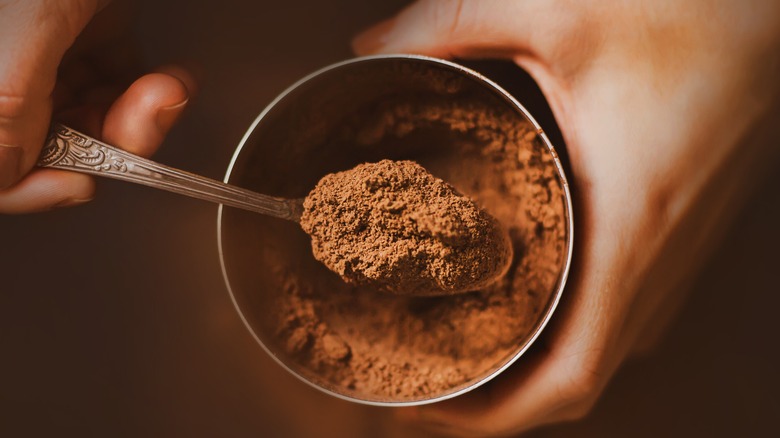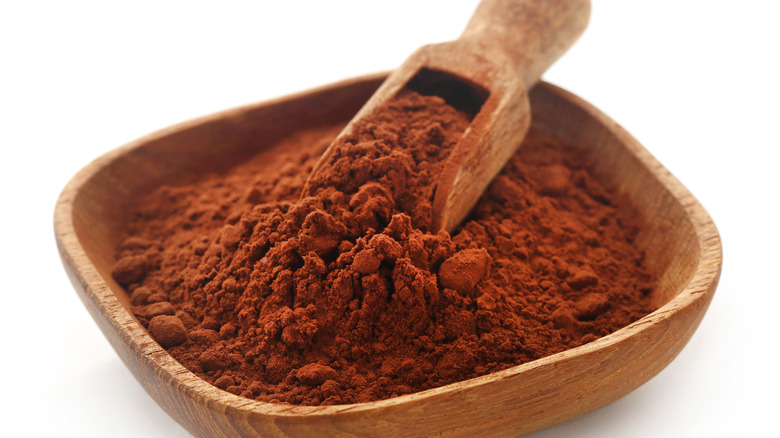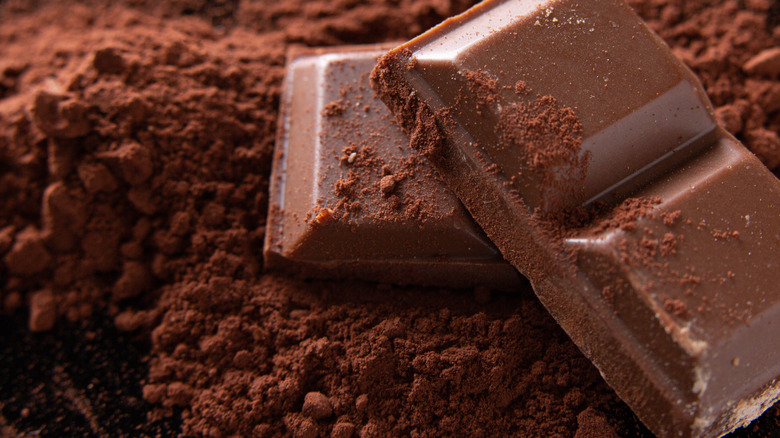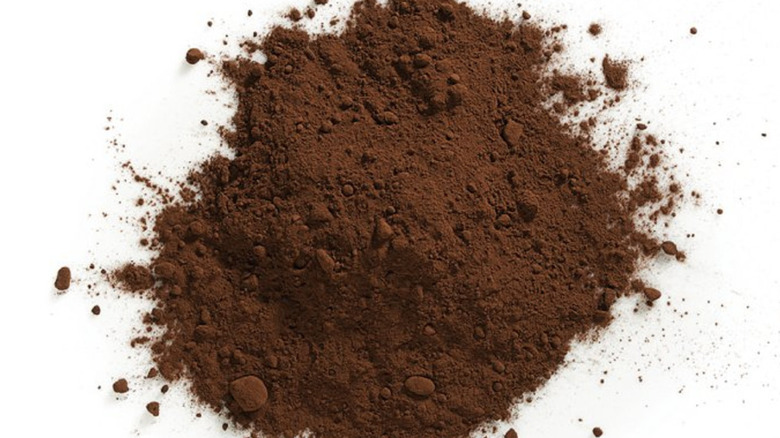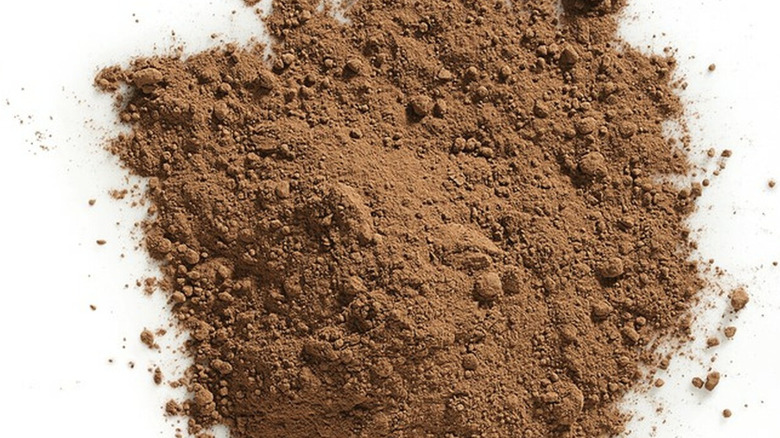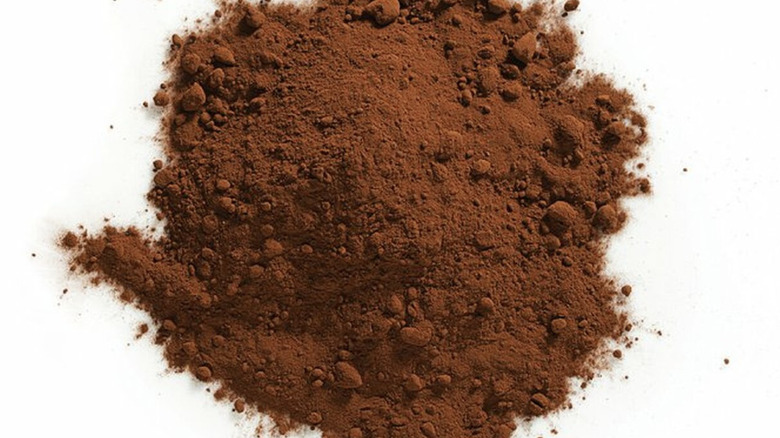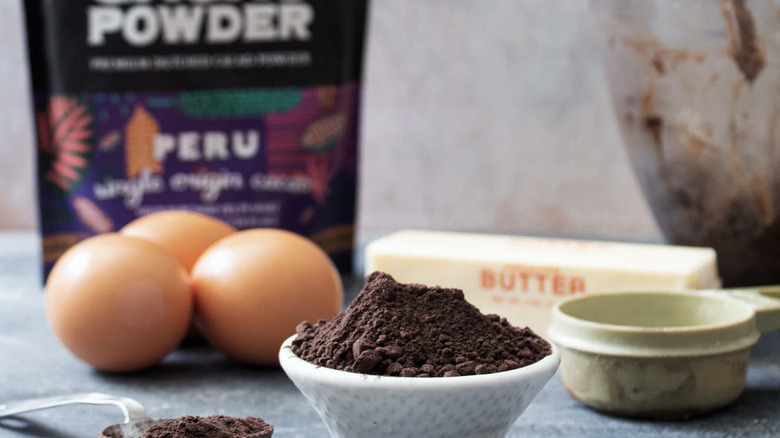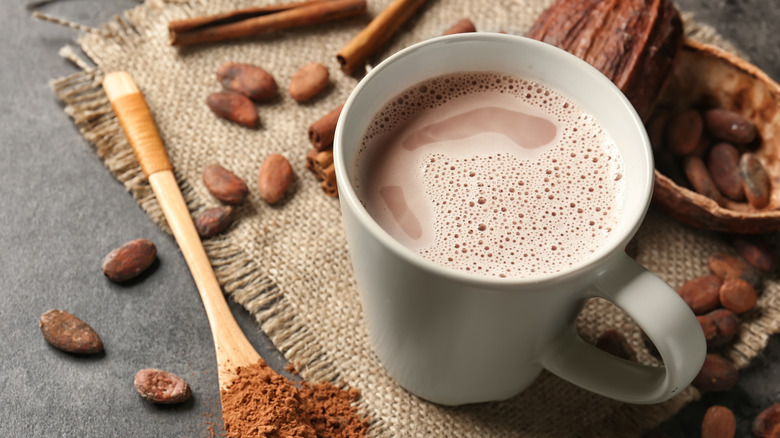The 8 Types Of Cocoa Powder And How To Use Them
While some bakers think that using baking chocolate is always preferable to using cocoa powder in recipes, cocoa powder is actually the most concentrated form of chocolate, according to ScienceDirect. Cocoa powder is made by fermenting and roasting cacao beans which are then pressed to remove most of the cocoa butter, leaving behind a cake that is then ground up into a powder.
The health benefits of the cacao bean are concentrated in cocoa powder compared to bar chocolate, which has added ingredients like fat and sugar. Cocoa contains phytonutrients, including antioxidants and anti-inflammatory compounds. According to the National Library of Medicine, it can even have beneficial effects on insulin resistance, cardiovascular health, and mood.
While cocoa powder is a versatile form of chocolate that is great for baking, it can also be used in frosting, sauces, and even in some savory dishes. Within categories of cocoa powder, one difference to be aware of is fat content. Higher-end brands tend to have a higher fat content than budget brands, leading to richer-tasting results.
Choosing the right cocoa powder for a recipe is the key to creating the right texture, flavor, and rise in baked goods. There are chemical differences in cocoa powder that can affect how it reacts with other ingredients, and if the wrong form is used, it can lead to sunken cupcakes, overly dense cakes, and dry, crumbly brownies. Read on to learn more about the eight kinds of cocoa powder and how to use them best.
Natural cocoa powder
Natural cocoa powder has the lightest color of all cocoa powders because it has not been alkalinized, producing naturally occurring tart, bitter, and astringent notes. According to Science Direct, natural cocoa powder is higher in the polyphenols that make cocoa powder a healthy food, and its natural bitterness can balance the sweetness in recipes. If a U.S. recipe calls for "cocoa powder," it generally refers to natural cocoa powder.
The acidity of natural cocoa powder is why you'll see it called for in recipes that use baking soda as a raising agent. Baking soda, which is alkaline, reacts with this acidity, giving your chocolatey baked goods a proper rise. The fat content of natural cocoa powder can vary widely from 10 percent fat in Hershey's Cocoa Powder to higher-fat brands like Gerbs Allergy Friendly Foods running at 21.4 percent fat.
Natural cocoa powder can be substituted for unsweetened baking chocolate by using three tablespoons of cocoa powder for every ounce of unsweetened baking chocolate, plus one tablespoon of shortening to make up for the cocoa butter found in baking chocolate, according to Hershey. It can also be used in frosting and to make hot cocoa lighter in color with a fruity, bittersweet flavor. The compounds called anthocyanins in natural cocoa powder create the reddish hue of early forms of red velvet cake before diners began expecting a more vibrant red and bakers turned to food coloring, according to Mashed.
Dutched cocoa powder
Dutched cocoa powder has been alkalinized using a potassium carbonate wash, leading to deeper, earthier flavors as well as a darker color. The "Dutching" process that leads to this milder-tasting cocoa powder with caramel-like notes is named in honor of the creator of this technique, Dutch chocolate maker Conrad van Houten, according to Science Direct.
While many recipes call for natural cocoa powder, you'll find Dutched cocoa powder used in recipes that also include baking powder in addition to baking soda or in recipes that provide an acidic ingredient to react with the alkaline raising agent. Dutched cocoa powder's fat content varies by brand but is generally on the higher end, with Ghirardelli's Majestic Premium Cocoa Powder running at 20 to 22 percent fat and Valrhona Cocoa Powder at 21.4 percent.
Dutched cocoa powder can be used to flour pans for chocolate cakes, cookies, and brownies to avoid leaving a white coating on darker baked goods. Recipes that call for Dutched cocoa powder are darker in color with a fudgier taste. The earthier, mellower flavor of dutch cocoa powder makes it well-suited for boosting savory meals like chili.
Rouge or red cocoa powder
Rouge or red cocoa powder is yet another stop on the scale of Dutched cocoa powders. Red cocoa powder is further alkalized compared to regular Dutched cocoa powder and has a higher pH, but it isn't as far alkalinized as black cocoa powder.
Red cocoa powder has a deep, burgundy-adjacent reddish hue due to the Dutching process. Guittard, a chocolate brand that makes the popular and highly rated Cocoa Rouge Powder, says that this cocoa powder has a fudgy, bittersweet flavor right at home in pastries and baked goods like cakes, likely due in part to the fat content of 20 percent.
Another brand that makes red cocoa powder, King Arthur Baking, suggests using it in frostings and chocolate sauces when looking for "serious chocolate flavor." King Arthur Baking's cocoa powder contains 22 to 24 percent fat. While red velvet cake usually relies on natural cocoa powder (which is not Dutched), red cocoa powder can also lend a reddish hue to recipes containing an acid like buttermilk.
Double-Dutched or double-dark cocoa powder
Rather than being a result of stopping at a certain point of the Dutching process like red cocoa powder, Double-Dutch cocoa powder is a blended cocoa powder. It takes the best characteristics of Dutch cocoa powder and black cocoa powder to create a dark chocolate flavor, and it is best used in recipes for darker colors and deeper chocolate flavors.
By blending black cocoa powder (which can border on bitter and lead to a drier outcome in baked goods) with traditional Dutch cocoa powder, double-Dutch cocoa powder creates a deep chocolate flavor without the drawbacks of using pure black cocoa powder. It can be used to bake darker pastries approaching the hues of black cocoa powder as well, depending on the proportion of Double-Dutch cocoa powder in a recipe. According to King Arthur Baking, this cocoa powder (containing 16 to 18 percent fat) works well in baked goods like brownies, cookies, and cakes for that "intense" chocolate flavor.
Triple cocoa powder
Triple cocoa powder is another blended cocoa powder that combines the advantages of several different cocoa powders to create a well-balanced all-in-one product. According to King Arthur Baking, triple cocoa powder is made by mixing Dutch cocoa powder, natural cocoa powder, and black cocoa powder. This type of cocoa powder is unique to King Arthur Baking and excellent as an all-purpose cocoa powder.
This unusual cocoa powder is darker than natural cocoa or Dutched cocoa powder due to its black cocoa powder content. It has the earthier, mellower notes of a Dutched cocoa powder with some of the acidity and more rounded fruity chocolate notes of natural cocoa powder, along with a moderate percentage of cocoa fat in the range of 18 to 20 percent. Even better? It can be used as a substitute for either Dutch or natural cocoa powders, making it a handy addition to your pantry that can be used in any recipe.
Bensdorp Dutched cocoa powder
Bensdorp is a 180-year-old chocolate brand from Holland that makes high-quality cocoa powders using specially sourced West African cacao beans, according to parent company Barry Callebaut. King Arthur Baking is the only place to get your hands on Bensdorp Dutched cocoa powder as a home cook. This European-style cocoa powder has a deep chocolate flavor and a darker color with a slightly reddish tone.
It can be used as a substitute in recipes for baked goods and pastries, calling for Dutched cocoa powder, which tends to include baking soda or an acidic component. With a wide range of uses like regular Dutched cocoa powder, Bensdorp powder can also be used in brownies, cookies, cakes, and frosting for full-flavored, rounded chocolate notes. The higher fat content of this cocoa powder (22 to 24 percent fat) makes this a richer-tasting option that tastes great in hot cocoa and other unbaked recipes, like a from-scratch hot fudge sauce.
Black cocoa powder
You likely won't find black cocoa powder on your regular grocery store shelf. This specialty item is a form of Dutched cocoa powder that has been further exposed to the alkalinizing process, leading to a dark cocoa powder with a much higher pH than other varieties.
Black cocoa powder is a natural food coloring agent used to create dark baked goods — it can be used as a substitute for Dutched but not natural cocoa powders, according to Modern Mountain Flour Company. If using it as a substitute, it's best to only swap a portion of the cocoa powder in a recipe, according to Mashed. It's best used in conjunction with other cocoa powders, as black cocoa powder alone can lead to crumbly, dry baked goods. This could be partly due to its lower fat content, with Weirdo Good brand running at 10 percent and Modern Mountain Flour at about 14 percent.
If the color of black cocoa powder reminds you of Oreos, you're on the right track. Black cocoa powder can be truly black, but this depends on whether they are organic or not. According to organic black cocoa producer Weirdo Good, organic regulations only allow for certain amounts and kinds of alkalinizing agents to make black cocoa powder, preventing them from getting quite as dark as non-organic brands. They point out that there are drawbacks to a truly black cocoa powder: if the alkalinizing process is pushed far enough, ultra-Dutching cocoa powder can lead to bitter, burnt flavors.
Hot cocoa mix
While people have been drinking chocolate in some form since the Aztecs and possibly pre-Columbian cultures, according to Smithsonian Magazine, the first packaged hot chocolate mix was invented by a dairy company that overproduced dried milk for the Korean War, leading to the creation of Swiss Miss.
Hot cocoa mix combines unsweetened cocoa powder, sugar, and usually a dried form of milk, although many brands are free of dairy. Some companies include a powdered form of vanilla, and hot cocoa mix can also contain added ingredients that keep the powder free-flowing.
Hot cocoa mix, while absolutely delicious, is not purely cocoa powder and should generally not be used in baking because it contains other ingredients that will change the texture and flavor of baked goods. Hot cocoa mix can, however, be used in some recipes to boost waffles, make hot fudge sauce, and more.

